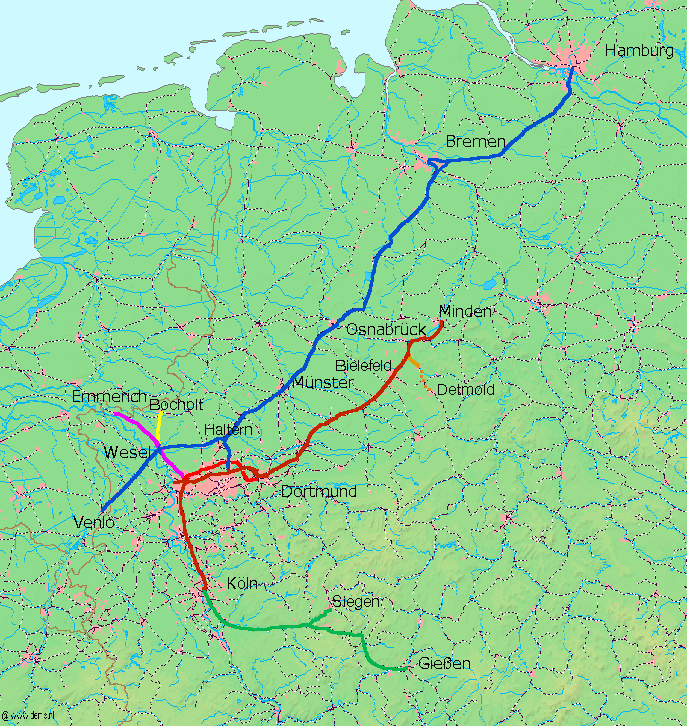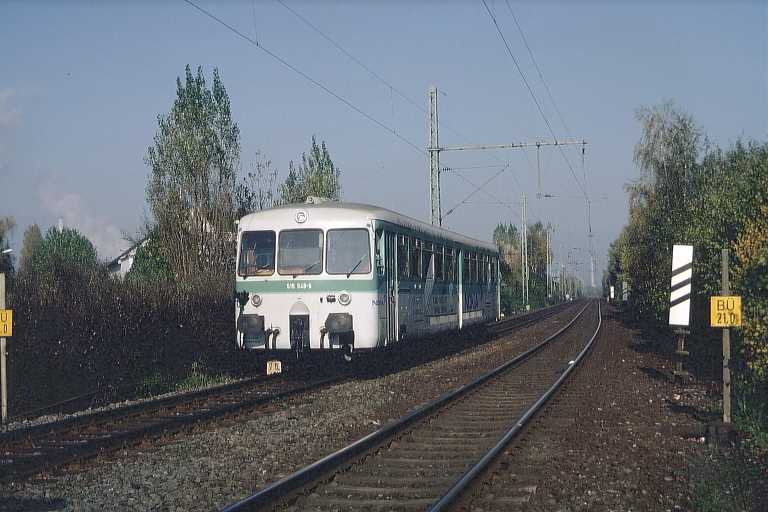|
Duisburg-Ruhrort–Dortmund Railway
The Duisburg-Ruhrort–Dortmund railway (also called the Cologne-Minden Emscher Valley Railway) was built by the Cologne-Minden Railway Company (''Cöln-Mindener Eisenbahn-Gesellschaft'', CME) in the area to the north of its original Duisburg–Dortmund railway, Ruhr line to improve connections to mines and factories in the northern Ruhr region, which is now in the German state of North Rhine-Westphalia. The track at the time of the Deutsche Reichsbahn mostly consisted of at least two tracks; now two-track, single track and completely dismantled sections alternate. The section from Oberhausen-Sterkrade station, Oberhausen-Sterkrade to Herne station, Herne was electrified between 1963 and 1975. History For a long time the main focus of the CME was on regional routes in the Rhineland and Westphalia. With the migration of the coal mining industry north from the vicinity of the Ruhr (river), Ruhr to the Emscher, the area between the two rivers became more of interest to the CME. T ... [...More Info...] [...Related Items...] OR: [Wikipedia] [Google] [Baidu] |
Cologne-Minden Railway Company
The Cologne-Minden Railway Company (German, old spelling: ''Cöln-Mindener Eisenbahn-Gesellschaft'', ''CME'') was along with the Bergisch-Märkische Railway Company and the Rhenish Railway Company one of the railway companies that in the mid-19th century built the first railways in the Ruhr and large parts of today's North Rhine-Westphalia. Founding The founding of the Cologne-Minden Railway Company in 1843 in Cologne ended a long struggle for a railway line between the Rhineland and the German North Sea ports, as well as the Prussian capital of Berlin. From the 1830s several railway committees in the cities of Düsseldorf, Cologne and Aachen attempted to find a solution with each other and the Prussian government. The focus of all these efforts was to avoid the Dutch duties on trade on the Rhine, which significantly increased the cost of import and export of goods via the Rhine. Some of the Cologne committee members under David Hansemann (1790–1864)—a merchant and banker fr ... [...More Info...] [...Related Items...] OR: [Wikipedia] [Google] [Baidu] |
Dortmund-Lütgendortmund Nord Station
Dortmund-Lütgendortmund Nord station is a railway station in the northern part of the ''Lütgendortmund'' district of the town of Dortmund, located in North Rhine-Westphalia, Germany Germany,, officially the Federal Republic of Germany, is a country in Central Europe. It is the second most populous country in Europe after Russia, and the most populous member state of the European Union. Germany is situated betwe .... Rail services References {{Authority control Railway stations in Dortmund ... [...More Info...] [...Related Items...] OR: [Wikipedia] [Google] [Baidu] |
Bottrop
Bottrop () is a city in west-central Germany, on the Rhine–Herne Canal, in North Rhine-Westphalia. Located in the Ruhr industrial area, Bottrop adjoins Essen, Oberhausen, Gladbeck, and Dorsten. The city had been a coal-mining and rail center and contains factories producing coal-tar derivatives, chemicals, textiles, and machinery. Bottrop grew as a mining center beginning in the 1860s, was chartered as a city in 1921, and bombed during the Oil Campaign of World War II. In 1975, it unified with the neighbouring communities of Gladbeck and Kirchhellen, but Gladbeck left it in 1976, leading to Kirchhellen becoming a district of Bottrop as Bottrop-Kirchhellen. It is also twinned with Blackpool, England. Boroughs The total area of the municipal territory is about . The longest north-south distance is , and from west to east . The highest peak within the city's territory is , the lowest one being above sea level. Bottrop is divided into three boroughs: Bottrop-Mitte (Bottrop-Ce ... [...More Info...] [...Related Items...] OR: [Wikipedia] [Google] [Baidu] |
Emscher
The Emscher () is a river, a tributary of the Rhine, that flows through the Ruhr area in North Rhine-Westphalia in western Germany. Its overall length is with an mean outflow near the mouth into the lower Rhine of . Description The Emscher has its wellspring in Holzwickede, east of the city of Dortmund. Towns along the Emscher are Dortmund, Castrop-Rauxel, Herne, Recklinghausen, Gelsenkirchen, Essen, Bottrop, Oberhausen and Dinslaken, where it flows into the Rhine. At the centre of a vast industrial area with 5 million inhabitants the river is biologically dead, as it was used as an open waste-water canal from the end of the 19th century. The partial collapse of many coal mines along the Emscher's route made the option of subterranean sewer pipes running alongside unworkable, as they would break too easily. Owing to the steady flow of spoil from the mining industry it has been impossible for the route of the Emscher to be maintained and its mouth into the Rhine has shifted n ... [...More Info...] [...Related Items...] OR: [Wikipedia] [Google] [Baidu] |
Bundesautobahn 42
is an autobahn in western Germany. It connects Kamp-Lintfort with Castrop-Rauxel, linking several large cities in the Ruhr area, such as Dortmund, Duisburg, the North of Essen and Gelsenkirchen. It is colloquially known as ''Emscherschnellweg'', after the river Emscher The Emscher () is a river, a tributary of the Rhine, that flows through the Ruhr area in North Rhine-Westphalia in western Germany. Its overall length is with an mean outflow near the mouth into the lower Rhine of . Description The Emscher h ..., which it roughly follows. Construction went underway in the 1970s and 1980s. Exit list External links 42 A042 {{Germany-road-stub ... [...More Info...] [...Related Items...] OR: [Wikipedia] [Google] [Baidu] |
Bochum–Gelsenkirchen Railway
The Bochum–Gelsenkirchen railway, also known as the Glückauf-Bahn (referring to Glück auf, the traditional German miners greeting), is a passenger railway from Bochum Central Station (''Hauptbahnhof'') to Gelsenkirchen Central Station in the German state of North Rhine-Westphalia. It is served by Regionalbahn passenger service RB 46). It is also used by freight traffic from Bochum freight yard at the former Bochum Süd station and Bochum-Präsident to Gelsenkirchen-Schalke Nord. The line was built in sections between 1867 and 1876 of the Bergisch-Märkische Railway Company. The curve connecting to Bochum Central Station was opened in 1979. Passengers Until 1978, the Deutsche Bundesbahn passenger service ran from Bochum-Langendreer via Bochum-Nord, Bochum- Riemke to Wanne-Eickel (see Bochum-Riemke–Wanne-Eickel line below). After the construction of a connecting curve from Bochum Central Station (''Hauptbahnhof'') to the line towards Riemke in 1979, passenger services ... [...More Info...] [...Related Items...] OR: [Wikipedia] [Google] [Baidu] |
Wanne-Eickel Hauptbahnhof
Wanne-Eickel Hauptbahnhof is a railway station in the former city of Wanne-Eickel, now part of Herne in western Germany. History The station grew out of the ''Pluto-Thies'' freight yard, opened in 1856 on the Duisburg–Dortmund line section of the Cologne-Minden Railway Company's trunk line, which was opened in 1847. In 1864, a halt was opened there for passengers. In 1867 a new freight yard was opened, which was initially called ''Pluto'', but changed to ''Wanne'' (literally “basin”, a description of the landscape) in 1869, because the surrounding villages could not agree on a name for the yard. The station's name was reflected in 1875 when the villages of Eickel, Bicker, Crange, Holsterhausen and Röhlinghausen were merged under the name of Amt Wanne. With the opening of the line to Münster on 1 January 1870, Wanne station became a railway junction. In 1913 the station building and the track work were rebuilt and extended. After the formation of the city of Wanne-Eic ... [...More Info...] [...Related Items...] OR: [Wikipedia] [Google] [Baidu] |
Bundesautobahn 43
is an autobahn in western Germany, connecting Münster via Recklinghausen to Wuppertal. It is an important bypass for traffic coming from the A 1 wanting to go to the western Ruhr valley and wanting to avoid tailbacks at the Kamener Kreuz near Dortmund Dortmund (; Westphalian nds, Düörpm ; la, Tremonia) is the third-largest city in North Rhine-Westphalia after Cologne and Düsseldorf, and the eighth-largest city of Germany, with a population of 588,250 inhabitants as of 2021. It is the la .... Exit list , - , colspan="3", ---- External links 43 A043 {{Germany-road-stub ... [...More Info...] [...Related Items...] OR: [Wikipedia] [Google] [Baidu] |
Bochum–Essen/Oberhausen Railway
The Bochum–Essen/Oberhausen railway was built by the Bergisch-Märkische Railway Company (''Bergisch-Märkische Eisenbahn-Gesellschaft'', BME) to the north of its main line through the central Ruhr to tap traffic from mines and factories in the northern Ruhr region, which is now in the German state of North Rhine-Westphalia. History For a long time, the main focus of the BME was on its lines through the Bergisches Land (the Witten/Dortmund–Oberhausen/Duisburg railway) and along the Ruhr (the Ruhr Valley Railway), which connected to local factories and coal mines. With the migration of the coal mining industry north from the vicinity of the Ruhr to the Emscher, the area between the two rivers became more of interest to the BME. This area had previously only been served by the Rhenish Railway Company (RhE) and the Cologne-Minden Railway Company (CME) with its more northerly Ruhr lines. Already in 1847, the CME had built its main line between Duisburg and Dortmund, which ... [...More Info...] [...Related Items...] OR: [Wikipedia] [Google] [Baidu] |
Wanne-Eickel–Hamburg Railway
The Wanne-Eickel–Hamburg railway is the shortest railway link between the Metropole Ruhr and the Hamburg Metropolitan Region and hence one of the most important railway lines in northwest Germany. The Route runs over the cities Münster (Westfalen), Osnabrück and Bremen. It was built between 1870 and 1874 by the Cologne-Minden Railway Company (CME) based in Wanne-Eickel, and branched off their main (Cologne-)Deutz–Minden route as part of the Hamburg-Venlo railway. Today it is an electrified main line which has a minimum of two tracks throughout. Parts of the route are equipped with '' Linienzugbeeinflussung'' train control which enables speeds of up to 200 km/h to be attained. Due to its constant use by goods and passenger trains rolling along the line, day and night, it has been given the nickname ''Rollbahn'' ("Rolling Line"). History The railway was built by the Cologne-Minden Railway Company (CME) under contract to the Prussian state as the eastern element of a ... [...More Info...] [...Related Items...] OR: [Wikipedia] [Google] [Baidu] |
Herne Station
Herne station was opened in the inner city of Herne in the German state of North Rhine-Westphalia in 1847 together with the Cologne-Minden trunk line. It was located between the village of Herne, which had about 1,000 inhabitants, and the moated castle of Schloss Strünkede and was south of the current station on Von-der-Heydt-Strasse. It soon had a connection to the more southerly city of Bochum, which until 14 years later did not have its own station. For this reason the station was called ''Herne-Bochum'' until 1855. The station building The Cologne-Minden Railway Company opened a station in 1847. It was demolished in 1911 to make way for the current building, which was built by the Prussian state railways in 1914. It was modernised in 1970, the dome over the entrance hall was hidden above a suspended ceiling, the windows were removed and the window openings were bricked up. As part of a project called ''Internationale Bauausstellung'' (international building exhibition) ' ... [...More Info...] [...Related Items...] OR: [Wikipedia] [Google] [Baidu] |




